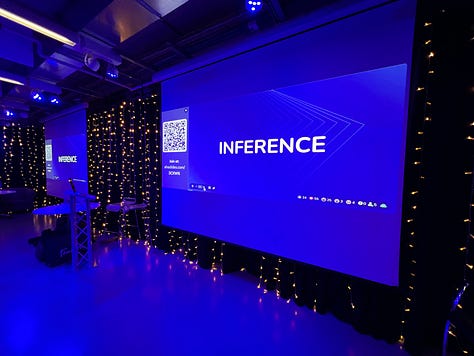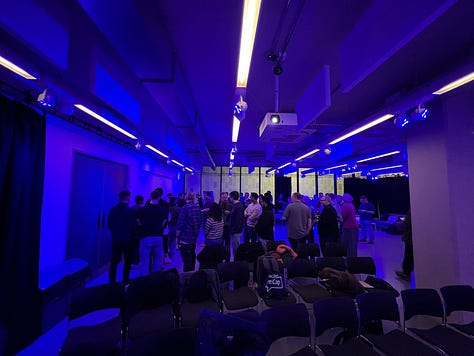#24 AWS re:Invent Recap! ❤️
This week, our expert is AWS Serverless Hero Michael Walmsley, our spotlight falls on AWS author and educator Tobias Schmidt, we look at the latest AWS service releases, blog posts, & more!
Welcome
In last week’s issue, our serverless expert was AWS Community Builder Andres Moreno, and our spotlight fell on AWS Senior Developer Advocate Matheus Guimaraes!
This week, our serverless expert is AWS Serverless Hero Michael Walmsley, our spotlight falls on AWS author and educator Tobias Schmidt, we look at the latest AWS service releases, blog posts, hints and tips, news and more!
This week’s newsletter is sponsored by Leighton.
A Glimpse into My Week 🎤
This week, we had the pleasure of hosting Matheus Guimaraes at the AWS North-East User Group meet-up, where he did a fantastic AWS re:Invent Recap session!



I will also be in Manchester next week for Serverless Days Manchester, which will be a fantastic event, and I am looking forward to meeting friends, new and old!
⭐ I was also highlighted as one of the twenty AWS influencers to follow right now to grow in your career, which was nice to wake up to this week.
📰 Articles that caught the eye
Here are some of the stand-out articles I read during the week in the World of Serverless.
⭐ My favourite this week was the article by Chris Ebert on using Amazon Bedrock Agents to utilise the U.S National Parks data using conversational AI!
Ayman Aly Mahmoud discusses “Simplifying Serverless Workflows with EventBridge Pipes“.
Chris Ebert discusses ‘Building an AI Agent with AWS Bedrock for U.S. National Parks’.
Marcin Sodkiewicz discusses “Do you need P? Systems Correctness Practices at AWS“.
🎓 Ask the Expert
Each week, I ask a different serverless expert the same three questions to get their personal insights - this week, we have AWS Serverless Hero Michael Walmsley!
1. What is one common mistake you see teams making when implementing serverless solutions, and how can they avoid it?
I think one very common mistake teams make is not really digging into how services actually work and can be configured.
Serverless is super resilient and reliable, but only when you really understand how to combine the services and configure all the switches and dials to get the best out of services - You might call this "Lazy Configuration". This and knowing your expected transaction volumes, which is an enterprise pet peeve of mine - I do a lot of systems integration work, and many times when I walk into a program with issues or problems, there is often no data on expected volumetrics. It’s hard if you are doing green-field development, but volumes allow you to work on resiliency and reliability from day 1, which makes a huge difference when you get to that go-live moment.
A great example of this is SQS and Event Source Mapping configuration. Event source mapping for lambda has had a max concurrency setting since January 2023. The combination of SQS and the max concurrency setting is something everyone can make use of to add flow control to their solutions for any asynchronous EDA processing to ensure you don't overrun downstream services.
If you happen to know your expected transaction volumes, then you can calculate a reasonable concurrency setting to ensure you don't go over any known rate limits (every system has a rate limit). I spoke about this in my re: Invent talk last year Serverless Scalability Unleashed (DEV319).
So really get to know the services you use and learn how to configure them to get the best out of them - configuration settings exist because customers have real problems that need solving - learn and use them, get off the lazy train!
2. Which serverless tool or service are you most excited about right now, and why?
I am super excited about S3 Tables right now - the automated management of the table data to keep Amazon Athena queries working efficiently is super useful for analytics use cases and means we can focus on more of the hard parts of system design and building. I can't wait to find some time to write about our cases in more detail and really dig into S3 table’s capabilities.
3. What is your favourite trick or tip when working with serverless that the readers may find interesting?
A lot of people struggle with observability - there is a reason why there are so many observability vendors out there! I do a lot of work in systems integration, and tracing across a serverless landscape feels hard because you're building a distributed system!
CloudWatch Insights is a powerful service that allows you to search across your CloudWatch log groups - in fact, since last year, there has been no limit on the number of log groups you can add, which is awesome.
For tracing transactions across a serverless landscape, I like to wrap my data into an "envelope" (kind of like the old SOAP days) and include a correlation key for every transaction and other interesting data in the meta attribute.
With your correlation data inside the event data, you guarantee that it will traverse most cloud services without writing any additional code. If you do this and have consistent logging, you can log the meta envelope data with complete safety whilst ignoring the actual data element, which can potentially contain Personally Identifiable Information (PII).
You are now able to trace where data goes across a complex distributed landscape with minimal effort and can achieve this using only AWS CloudWatch. The observability products out there are all pretty awesome, but often you get projects where SaaS providers are not allowed, for example, government customers.
✅ Bonus tip: join the hashtag#believeinsls discord! There is a community there to answer any questions you may have without getting overzealous on serverless or without judgment! Check it out!
🚀 New Releases
Here are the latest releases this week in the AWS World:
⭐ The most interesting for me this week is the operation-level caching in AWS AppSync!
Amazon Q generative SQL is now available in additional regions.
Amazon OpenSearch Serverless expands support for time-series workloads up to 100TB.
AWS AppSync enhances resolver testing with comprehensive context object mocking.
AWS AppSync GraphQL introduces operation-level caching for faster GraphQL API responses.
Amazon DynamoDB now supports auto-approval of quota adjustments.
AWS Step Functions expands data source and output options for Distributed Map.
CloudWatch Application Signals now supports Runtime Metrics for .NET Applications.
🔥 Tip: Check out https://aws-news.com/ for the very latest up-to-date serverless releases as they happen, created by the talented AWS Serverless Hero Luc van Donkersgoed.
👷🏻 Tools & Frameworks
Check out the latest open-source frameworks, news, and tool updates from the past week.
EventCatalog 2.20.0 is now out. EventCatalog now supports llms.txt, an emerging standard that helps AI-powered tools better understand your documentation
Expressive Code - Present your source code on the web, making it easy to understand and visually stunning. All batteries included!
Open-Source Eclipse IDE - Microsoft Previews Copilot AI for Open-Source Eclipse IDE.
💡 Hints & Tips
Each week, I share quick hints or tips based on things I notice in day-to-day engineering life.
⭐ [Tip 1] - Want to edit any webpage like a document? Just run this in your browser console:
document.designMode = "on";This enables direct editing of web content, making it great for testing layouts, tweaking text, or experimenting with UI changes—no need to edit the HTML manually! Example below:
⭐ [Tip 2] - Cloud Micro-learning on the go! Do you want free actionable cloud-based cards for micro-learning the fundamental cloud concepts and patterns? If so, check out Cloud Cards:
I built this for people who want to learn on the go, whether that be sitting on the bus on the way to work or in between meetings while grabbing a coffee! Watch out for new categories coming very soon!
✖️ Social of the Week
This week’s social is on X/Twitter by Dave Farley:
I love this tweet as it is how I aim to architect and design my solutions - I try to keep the solution as simple as possible. It’s where embedding generative AI into solutions, for example, adds a layer of complexity with its non-determinism and some of the limits that can be hit on AWS currently. I’m not saying not to do this, of course, but to really get guardrails around it, as it is not simple.
It’s also why I like to integrate serverless technologies natively, so I can visualise flows and patterns up front and minimise the amount of glue code that I need to write. As Michael said earlier, we really need to understand these service configurations to make the best of this approach.
🎙️ YouTube & Podcasts
Here are some of my favourite videos and podcasts this week.
⭐ My favourite this week was the session by Wanjiko Kahara, talking through the basics of prompt engineering on AWS.
“How far can I get in an hour with Serverless Framework?“ with Andres Moreno.
Learn Better Prompt Engineering in 7 Minutes with Wanjiko Kahara.
A Practical Guide To User Stories & Requirements with Dave Farley.
Stuart Clark covers Code Default Arguments in AWS Lambda Functions using Python.
From XP to TCR & Limbo with Kent Beck & Daniel Terhorst-North.
Weekly Case Study 🔍
This week’s case study comes from Adobe.
By using Amazon EC2 P5 and P4d instances with NVIDIA GPUs, Amazon EKS, FSx for Lustre, and S3, Adobe increased training capacity 20x in six months, ensuring high-performance AI model development. Firefly’s deep integration and Reinforcement Learning with Human Feedback (RLHF) enhanced user-driven creativity, making Generative Fill the most-used feature in Photoshop. AWS’s scalable infrastructure enabled cost-efficient inference, allowing Adobe to optimise performance across regions. With Content Credentials ensuring transparency, Adobe set a new standard for ethical AI in the creative industry, solidifying its leadership in generative AI.
🗣️ Inspirational Quotes and Thoughts
This week’s inspirational quote comes from software thought leader Dave Thomas:
"Big design up front is dumb. Doing no design up front is even dumber."
— Dave Thomas
Over-planning every detail before coding is inefficient as requirements will change, but starting with no design at all leads to chaos and costly rework. The key is to plan “just enough” up front to establish a solid foundation while staying flexible for future adjustments. Like anything, there is a sweet spot!
Where do you find the “sweet spot” currently?
🗳️ Poll of the Week
In last week’s poll, we asked the question “What approach do you take to validating events with schemas?:”, where 0% said they validate events before publishing, 25% validate before consuming, 63% said both, and the remaining 13% said they don’t validate at all.
My personal approach is to validate both before publishing (being a good event citizen) and when consuming (belt and braces), especially when dealing with event-carried state transfer.
This week, we ask the question, “Is sustainability a key factor in your cloud workload architecture?“. Please feel free to add comments:
📅 Serverless Events
The following serverless events are upcoming, so mark your calendars:
ServerlessDays Manchester 2025 - 20th Feb 2025
AWS Community Day Italy - 2nd April 2025
AWS Community Day Romania - 10th April 2025
AWS Community Day Turkey - 19th April 2025
⭐ Spotlight
This week’s spotlight falls on AWS author and educator Tobias Schmidt!
As a seasoned software engineer and educator, Tobias has helped countless developers navigate cloud challenges, drawing from his experience migrating production workloads and building large-scale applications. Tobias is the author of AWS Fundamentals and The CloudWatch Book (go check them out), giving essential guidance for cloud professionals. Thank you for what you do for our wonderful community!
👋🏼 Wrapping Up
Thank you for reading the latest Serverless Advocate Newsletter!
If you want to find out a little more about me, please have a look at:
https://www.serverlessadvocate.com/
See you next time,
Lee















